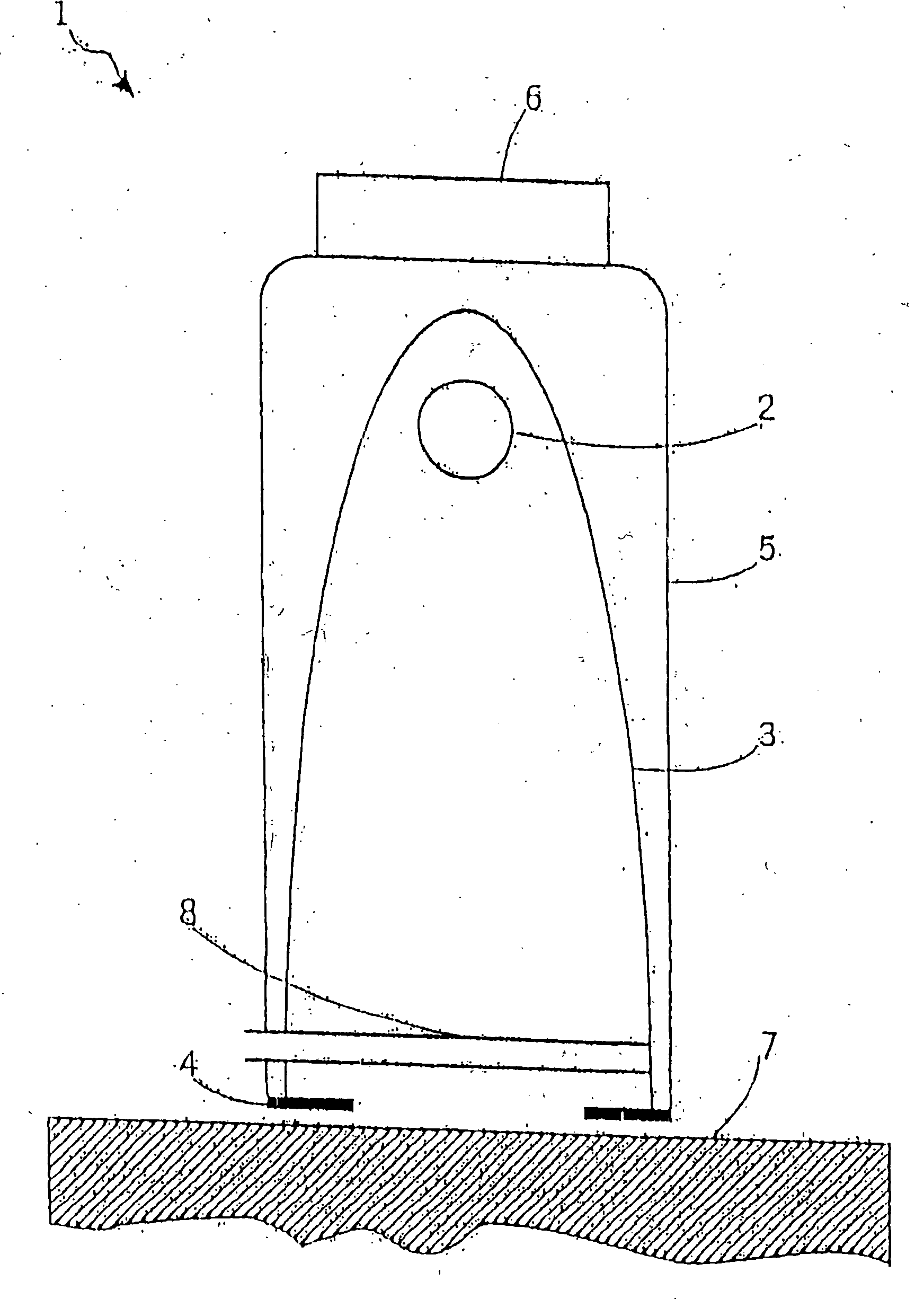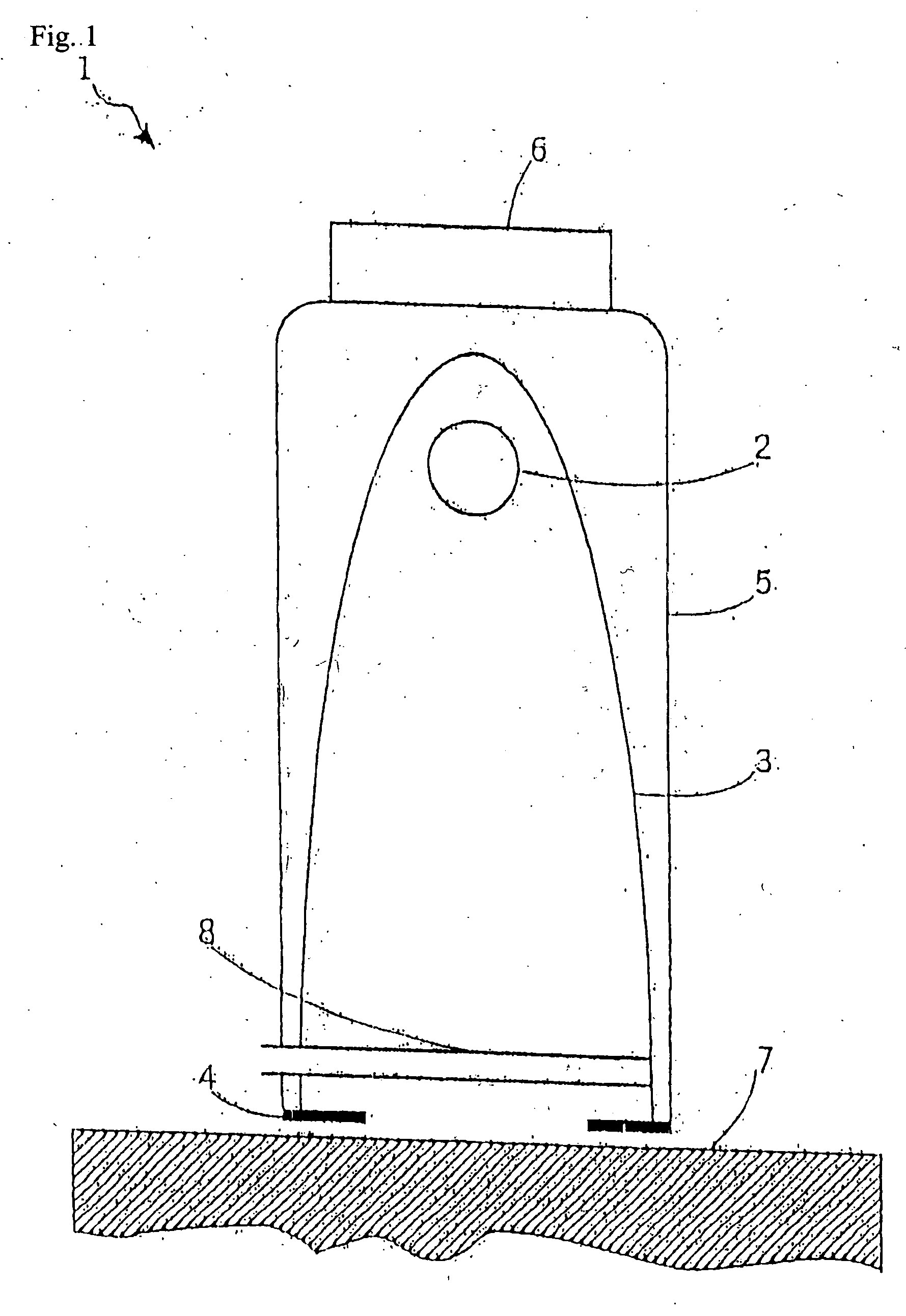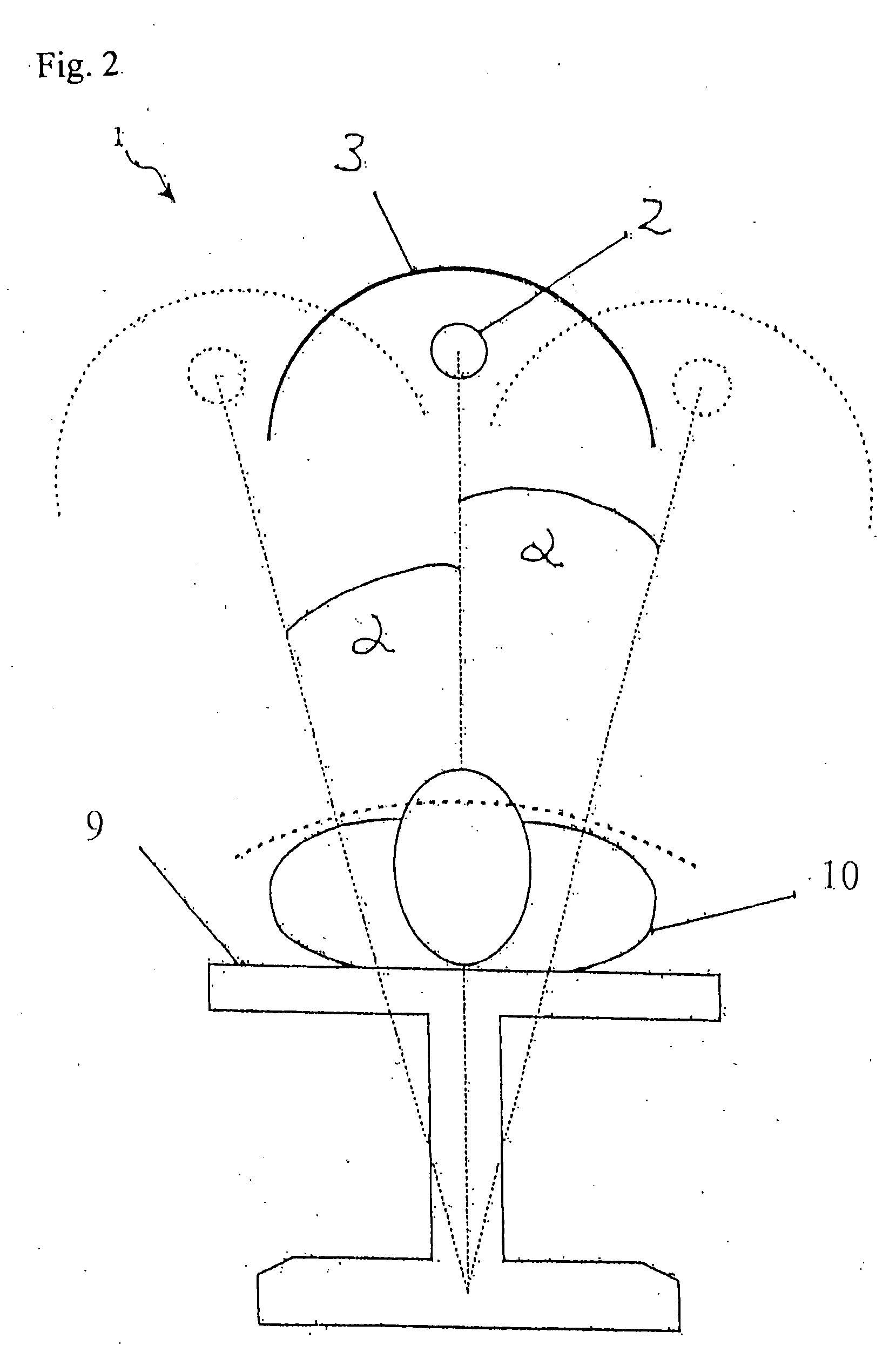[0023] The present invention utilizes the discovery that during pulsed irradiation—other than described in the scientific literature—the generation of
singlet oxygen during peak power time is higher than during cw-irradiation by several orders of magnitude. Another
advantage of
high peak powers is the fact that the deeper
layers of the skin also receive sufficient irradiation intensity, seeing that usually only a fraction of cw-
radiation reaches those deeper
layers due to the low
penetration depth of
blue light. In addition,
pulsed radiation energy has a stronger photobiological effect. If we assume an equal cumulated
radiation dose of cw-radiation and
pulse radiation, and also assume an intensity of 70 mW / cm2 for the cw-radiation, we would see that only 10 mW / cm2 would remain for photobiological effects, since 60 mW / cm2 of the radiation input would be neutralized by dermal antioxidants as a constant off-set. It is obvious that this decrease in photobiological efficiency by constant off-set can be effectively reduced by using
pulsed radiation.
Pulsed power peaks in the kW power range are only marginally affected by this dermal
antioxidant effect. The average
energy supply is so chosen as to avoid
necrosis of the cells but merely to induce
apoptosis. Likewise, the treatment stays below the
ablation threshold aimed at in EP 0 565 331 B1.
Tissue ablation occurs when energy higher than 2500 J / cm2 is deposited in the tissue within a period of time that does not allow heat exchange between adjacent
layers. Due to the time modulation by pulse generation, where the
irradiation time is below the relaxation period of the uppermost layer of the skin, in the outer layer of the skin
hyperthermia is achieved which can easily be removed. Light in the range of 400-500 nm loses 50% of its energy after 200 μm. The estimated
thermal relaxation period for a structure with a
diameter of 200 pm is approx. 20 ms, meaning that, assuming a
retention period of the light of <20 ms, only the outer layers of the skin are heated without any energy deposition in the deeper layers.
[0030] In order to improve the
diffusion of
oxygen and the thermal cooling, there is a longer pulse-off interval between a few seconds to a few minutes after a series of preferably, for example, 100 pulses, before generating a new pulse series. due to the extremely long
diffusion times of
oxygen there may also be applications where just one
single pulse is administered before a longer pulse-off interval. These pauses can vary in length from one to several hours. Particularly for the treatment of chronic diseases the irradiation arrangement can be assigned to the patient as, for example, a belt, an irradiation
blanket or an irradiation
bed so as to give, for example, one pulse per hour. These long pauses make thermal problems or the
diffusion of
oxygen in tissues negligible.
[0039] Unexpectedly, it was discovered that
gallium iodide-doped mercury medium-resp.
high pressure lamps do show neither broadening nor an inversion of the
gallium emission at 403 and 417, even if the overload is 100-1000 times above normal operating conditions. A gallium
iodide-doped mercury
discharge lamp run under
normal conditions with a
discharge current of 1.5 A / cm2 cross-sectional area of the
discharge vessel could be run in
pulse operation mode with 1000 A / cm2 cross-sectional area of the discharge vessel without reduction or inversion of the gallium emission lines. A possible explanation relates to the fact that metallic gallium has a
boiling point of 2200° C. so that the gallium
vapor pressure can be neglected even under
pulse operation of the lamp. However, there is a disintegration of mercury
iodide into mercury and
iodine. During the
plasma discharge,
iodine forms an instable compound with gallium, gallium tri-iodide. Gal3 shows a marked increase of
vapor pressure even at rather low temperatures. The absent inversion of the gallium emission could be explained by the fact that Gal3 is only stable up to a certain pressure and there is a rapid disintegration into gallium and
iodine if the pressure is increased any further. Therefore a relatively stable gallium
vapor pressure can be maintained even if there is rapid temperature increase during
pulse operation. After the disintegration of the compound, Gal3 there is a condensation of metallic gallium which does not take part in the discharge and possible self-absorption of the gallium emission. This unexpectedly discovered effect could therefore be related to a paradox constant vapor pressure covering a temperature range between 200 and almost 2200° C. Mercury iodide disintegrates early into mercury and iodine, so that there is always iodine available to form a compound with the gallium. Mercury pressure therefore may increase rapidly with the
energy load, thus providing excitational energy for the gallium emission. Due to the relatively stable gallium vapor pressure, most of this energy is emitted as gallium spectrum lines at 403 and 417 nm.
[0044] In another preferred embodiment a
pulsed radiation source is operated in simmer mode, thus allowing to increase the pulse slope.
[0045] It is also possible to combine the scan movement with a pulsed radiation source, in order to further decrease the achievable pulse lengths for an assumed treatment area, which is also advantageous in view of
thermal relaxation.
[0052] By increasing the irradiated area, the
energy density at the surface decreases so that the duration of the widened irradiation area may be longer. This accomplishes that a larger number of absorbing chromophores can be photochemically excited over a longer time interval than would be possible during a short pulse. The absence of radiation peaks within the radiation area impede the local bleaching resp. the local shortage of oxygen. Furthermore, there is a local maximum in the central area of the irradiation field since the scattering of all rays add and increase the radiation in the central area. Depending on the tissue parameters an the spectrum, the optimal irradiation area has a
diameter of more than 4 mm and less than 60 mm since by using large diameters the scattering of the marginal rays does not increase the intensity in the central area. By choosing an optimal
beam diameter, a higher intensity in the central irradiation area resp. a higher
penetration depth can be achieved. A further widening of the irradiation area leads to a decrease in
power density proportional to the increase of the area so that no light reaches the deeper tissue layers. Furthermore, the re-irradiation period of ever larger tissue areas shortens so that heat extraction resp. become more difficult.
 Login to View More
Login to View More  Login to View More
Login to View More 


